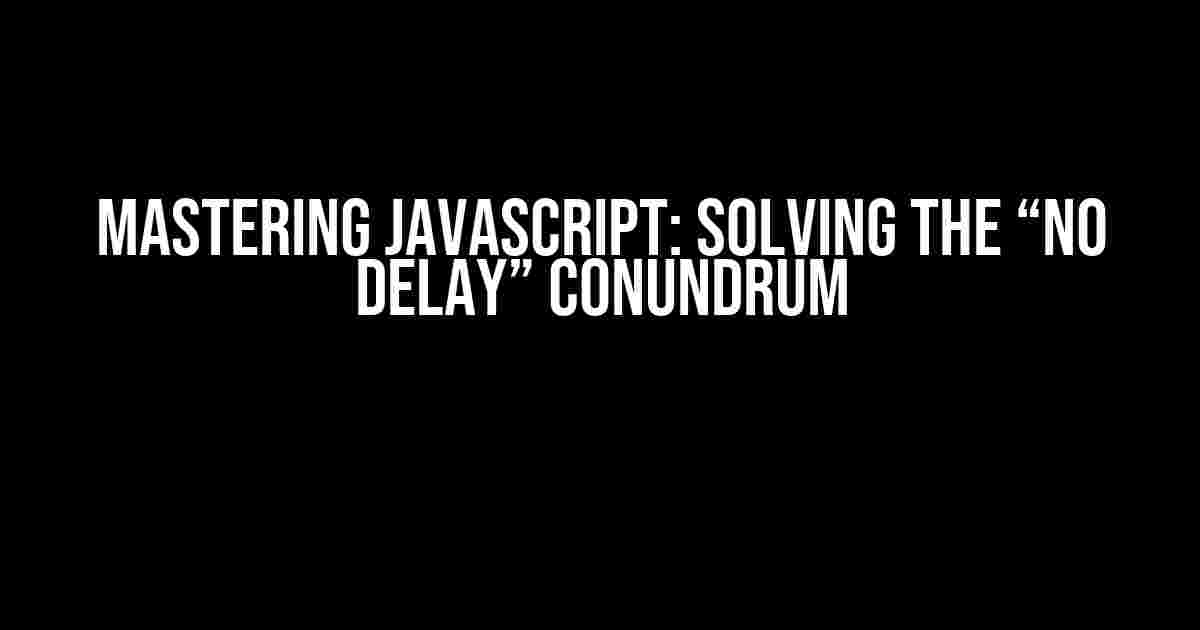Have you ever found yourself stuck in a situation where you need a JavaScript code to run immediately after the screen stops, without any delay? You’re not alone! In this comprehensive guide, we’ll dive into the world of JavaScript and explore the best practices to achieve this exact functionality. Buckle up, folks, as we solve the “no delay” puzzle together!
The Problem: Understanding the “No Delay” Requirement
Before we dive into the solution, let’s break down the problem. When you want a JavaScript code to run as soon as the screen stops, you’re essentially asking for immediate execution. This means that your code should trigger without any delay, as soon as the screen becomes static. Sounds simple, right? Well, not quite.
Challenges and Considerations
- Screen Stop Detection**: How do you detect when the screen has stopped? Is it when the user stops scrolling, or when the animation completes?
- Browser Rendering**: Browsers have different rendering engines, which can affect the timing of your code execution.
- Device Variety**: With countless devices and screen sizes, you need a solution that’s adaptable and reliable.
Solution 1: Using RequestAnimationFrame()
One of the most popular methods to achieve “no delay” is by utilizing the `requestAnimationFrame()` function. This approach allows you to schedule a function to run as soon as the browser is ready to repaint the screen.
function myFunction() {
// Code to run immediately after screen stops
console.log("Screen has stopped!");
}
window.requestAnimationFrame(myFunction);
How it Works
`requestAnimationFrame()` takes a callback function as an argument, which is then executed as soon as the browser is ready to repaint the screen. This ensures that your code runs when the screen is stationary, with minimal delay.
Solution 2: Debouncing with setTimeout()
An alternative approach is to use a debouncing technique with `setTimeout()`. This method involves wrapping your code in a function that’s delayed by a short interval, allowing the screen to settle before execution.
function debounce(func, wait) {
let timeout;
return function() {
const context = this;
const args = arguments;
const later = function() {
timeout = null;
func.apply(context, args);
};
clearTimeout(timeout);
timeout = setTimeout(later, wait);
};
}
const myFunction = debounce(() => {
// Code to run immediately after screen stops
console.log("Screen has stopped!");
}, 100);
window.addEventListener("scroll", myFunction);
How it Works
The debouncing function creates a timeout that’s cleared and recreated on each scroll event. Once the scroll event stops, the timeout is allowed to complete, executing the wrapped function.
Solution 3: Using IntersectionObserver
A more modern approach involves leveraging the `IntersectionObserver` API to detect when the screen has stopped. This method provides a more elegant solution, especially when working with animations.
const observer = new IntersectionObserver((entries, observer) => {
if (entries[0].isIntersecting) {
// Code to run immediately after screen stops
console.log("Screen has stopped!");
observer.unobserve(document.body);
}
}, { threshold: 1.0 });
observer.observe(document.body);
How it Works
The `IntersectionObserver` API allows you to observe an element’s visibility within the viewport. By setting the `threshold` to 1.0, you can detect when the entire element is visible, indicating that the screen has stopped.
Comparison and Best Practices
| Solution | Pros | Cons | Browser Support |
|---|---|---|---|
| requestAnimationFrame() | Low overhead, efficient | May not work on older browsers | IE 10+, Chrome 24+, FF 23+ |
| Debouncing with setTimeout() | Wide browser support, flexible | May cause performance issues on high-scrolling scenarios | IE 6+, Chrome 1+, FF 1+ |
| IntersectionObserver | Modern, efficient, and elegant | Requires modern browser support | IE 11+, Edge 15+, Chrome 51+, FF 55+ |
Conclusion
In conclusion, achieving “no delay” in JavaScript requires a deep understanding of the underlying challenges and considerations. By using one of the three solutions outlined above – `requestAnimationFrame()`, debouncing with `setTimeout()`, or `IntersectionObserver` – you can ensure that your code runs immediately after the screen stops, without any delay.
Remember to weigh the pros and cons of each solution, considering factors like browser support, performance, and readability. By mastering these techniques, you’ll be well-equipped to tackle even the most complex JavaScript challenges.
Further Reading and Resources
- MDN: requestAnimationFrame()
- CSS-Tricks: Debouncing and Throttling Explained
- MDN: IntersectionObserver
Stay curious, keep coding, and remember – there’s no delay in mastering JavaScript!
Frequently Asked Question
Get answers to the most common questions about running code immediately after the screen stops!
What is the main challenge when it comes to running code after the screen stops?
The main challenge is that the code execution is delayed due to the screen stopping, causing a lag in the execution of the code.
Why does the screen stopping cause a delay in code execution?
The screen stopping can cause a delay in code execution because the system is busy handling the screen stop event, and the code execution is put on hold until the event is fully processed.
How can I ensure that my code runs immediately after the screen stops?
You can use a callback function or an event listener to detect when the screen stops, and then execute your code immediately after the event is triggered.
What is an example of a callback function that can be used to run code after the screen stops?
An example of a callback function is a `onStop` event listener, which can be used to execute code when the screen stops. For example: `screen.onStop(function(){ /* code to run */ });`
Can I use a timer to delay the code execution after the screen stops?
No, using a timer to delay the code execution is not recommended as it can lead to unpredictable behavior and may not work as expected. Instead, use a callback function or event listener to ensure that the code runs immediately after the screen stops.

